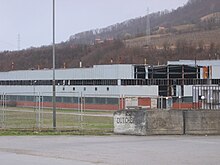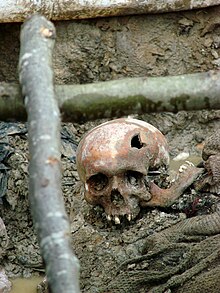Siege of Srebrenica
The subsequent massacre of the town's male population led to the deaths of more than 8,000 Bosniak men and boys, and is considered the largest act of mass murder in Europe since the end of World War II.The commander of Bosniak forces in the enclave, Naser Orić, was found guilty of failing to prevent the mistreatment of VRS prisoners held in Srebrenica between September 1992 and March 1993.[6] Later renamed the Republika Srpska,[7] it developed its own military as the JNA withdrew from Croatia and handed over its weapons, equipment and 55,000 troops to the newly created Bosnian Serb army.[12][2] Taking place throughout the municipalities of Srebrenica, Vlasenica, Rogatica, Bratunac, Višegrad, Zvornik and Foča,[13] the purpose of these operations was to create in eastern Bosnia a contiguous Serb-controlled land having a common border with Serbia.[17] In the words of the International Criminal Tribunal for the former Yugoslavia (ICTY):[18] Between April 1992 and March 1993, the town of Srebrenica and the villages in the area held by Bosniaks were constantly subjected to Serb military assaults, including artillery attacks, sniper fire, as well as occasional bombing from aircraft.Serb soldiers and paramilitaries surrounded a Bosniak village or hamlet, called upon the population to surrender their weapons, and then began with indiscriminate shelling and shooting.All this resulted in a great number of refugees and casualties.In his ICTY testimony, VRS Intelligence Chief Momir Nikolić recounted how Bosnian Serb forces were instructed to make life in Srebrenica unbearable in order to induce its civilian population to "leave en masse as soon as possible, realizing they cannot survive there."As part of this, Nikolić conceded that civilians were targeted and humanitarian aid blocked while fuel, food and other supplies for UN peacekeepers were halted so that "they could not be ready for combat".[27] At this time, the Srebrenica enclave had reached its peak size of 900 square kilometers, although it was never linked to the main area of Bosnian-held land in the west and remained "a vulnerable island amid Serb-controlled territory.The attack resulted in the Bosnian Serbs capturing 80 percent of the territory of the Srebrenica enclave once held by the 28th Division of the Army of the Republic of Bosnia and Herzegovina (ARBiH).[19] However, the VRS was forced to stop its offensive after the United Nations Security Council passed Resolution 819, which called for talks between the Bosniak and Bosnian Serb military leadership and the de-militarization of Srebrenica which was declared a "safe-area".[19] However, neither this counterattack nor the United Nations' designation of the town as a "safe area" ended Orić's raids against neighbouring Serb villages, which persisted at a rate of 3–4 per week as Bosniak forces searched for food to steal from the surrounding countryside.[33] With the VRS outnumbered and overextended countrywide in the winter of 1994, Mladić reasoned that it would be necessary to consolidate Bosnian Serb forces by eliminating one or more of the UN "safe areas" and the ARBiH garrisons located within them.Although attacking them would violate UN resolutions, Mladić believed that international forces would not confront the VRS as long as UNPROFOR units were vulnerable to suffering heavy casualties and hostage takings.[34] A subsequent hostage crisis in which UN personnel were seized and used as human shields to prevent NATO airstrikes destroyed the credibility of UN deterrence in Bihać and Sarajevo.Mladić then turned his attention to Srebrenica, Goražde and Žepa, whose seizure would release considerable VRS forces for redeployment against an expected Croatian Army–ARBiH offensive in western Bosnia, while strengthening the Bosnian Serb claim to the entire Drina valley in case of a future peace settlement.Due their location, Srebrenica and Žepa were the most vulnerable of the UN "safe areas" in Bosnia, in stark contrast to Goražde, where UN forces had resisted the VRS before being enforced by the ARBiH.[35] Bosniak raids from the town intensified in the beginning of 1995, with Orić's forces being ordered by the ARBiH to "reconnoiter, disrupt, divert and demoralize" VRS soldiers, who subsequently retaliated with counterattacks of their own.[19] In March 1995, Radovan Karadžić, President of the Republika Srpska, issued Directive 7, setting out the long-term strategy for VRS forces surrounding Srebrenica and Žepa.Launched on 6 July 1995, the operation ended the three-year-long siege of the town and was followed by the Srebrenica massacre, which has been ruled a crime of genocide by international courts of law.[44] On 2 July, Major General Milenko Živanović, then commander of the Drina Corps of the VRS, signed two orders laying out the plans for an attack on the UN protected area at Srebrenica codenamed Krivaja '95.[44] Alongside police and paramilitary units from both the Republika Srpska and Yugoslavia, as well as Greek and Russian volunteers, the VRS began attacking various points at the southern edge of the Srebrenica enclave on 6 July.[47] About 3,000-4,000 Bosniak civilians then fled to the UN compound in Potočari where all men between fourteen and seventy were segregated by the VRS, the great bulk of which were trucked to neighboring Serb-held Bratunac.[44] On 12 July, buses began arriving to take Bosniak women and children to Bosniak-held territory while Dutch troops helped Bosnian Serb forces in separating all men from the ages of 15 to 65."Dražen Erdemović – who confessed to killing at least 70 Bosniaks – was a member of the VRS 10th Sabotage Detachment (a Main Staff subordinate unit) and participated in the mass execution.Erdemović had to persuade his fellow soldiers to stop using a machine gun for the killings; while it mortally wounded the prisoners it did not cause death immediately and prolonged their suffering.[62] The next year, his trial began before the ICTY in The Hague on charges relating to his participation as VRS commander in the criminal conspiracy to perpetrate the Srebrenica genocide.[64] Momir Nikolić, who served as Assistant Chief of Security and Intelligence for the Bratunac Brigade, Drina Corp of the VRS, pleaded guilty for crimes against humanity in front of the ICTY and was sentenced to 20 years in prison.Together with another former VRS soldier who pleaded guilty, Dražen Erdemović, he testified in front of the ICTY against Karadžić, Mladić and Beara, providing valuable information about the execution and timeline of the massacre.




Bosnian WarSrebrenicaBosnia and HerzegovinaArmy of Republika SrpskaRepublika SrpskaSrebrenica massacreYugoslaviaRatko MladićRadislav KrstićZdravko TolimirŽeljko RažnatovićNaser OrićYugoslav People's ArmyYugoslav Ground ForcesSerb Volunteer GuardScorpionsGreek Volunteer GuardRussianArmy of the Republic of Bosnia and HerzegovinaSarajevoSarajevo JNA columnJNA campaignKupresZvornikVišegradPrijedor cleansingTuzla JNA columnGalaja resistanceBihaćJackalVrbas '92Corridor 92Majevica frontKorićani CliffsCroat–Bosniak WarMunja '93AzićiŽepčeKravicaŠtrpciTravnikMostarDeny FlightAhmićiTrusinaSovići/DoljaniDobrinjaBugojnoSadejstvoMokronogeGrabovicaNeretva '93Lukavac '93Stupni DoKrižančevo SeloBanja LukaBuna 94Tvigi 94Brana '94Washington AgreementStar '94Goražde air strikesBøllebankAmandaSarajevo incidentSpider2nd KupresShield '94Vučja PlaninaUdbina airstrikeWinter '94Vučja mountainMajevicaVlašićOrašjePale airstrikesTekbir '95Vrbanja BridgeKrivaja '95MassacreStupčanica '95VozućaMiracleSummer '95Deliberate ForceMistral 2Prijedor '95Southern MoveSerbo-CroatianSerbian Volunteer Guardmass murderWorld War IIgenocideInternational Criminal Tribunal for the former Yugoslaviamining townBosniaBosnian MuslimsCroatiaBosanski BrodSerbianethnic cleansingVlasenicaRogaticaBratunacMinistry of Internal AffairsPresidentSlobodan MiloševićPodrinjeMomir Nikolićhumanitarian lawResearch and Documentation Centermachine-gunnedSkelaniSarajevan SerbUnited Nations Security CouncilResolution 819safe-areaUnited NationsUnited StatesCanadianUNPROFORGoraždeCroatian Armyblack marketSiege of ŽepaDecisive victory